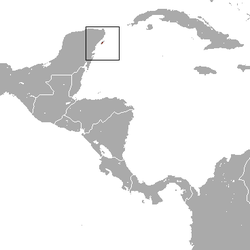| Common name | Scientific name and subspecies | Range | Size and ecology | IUCN status and estimated population |
|---|
| Angel Island mouse
| P. guardia
Townsend, 1912 | Ángel de la Guarda island in western Mexico | Size: 9–10 cm (4–4 in) long, plus 9–13 cm (4–5 in) tail [52]
Habitat: Shrubland [58]
Diet: Seeds, nuts, berries, fruit, insects, other invertebrates, and carrion [59] | CR
0–50  [58] [58]
|
|---|
| Aztec mouse 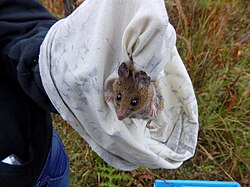 | P. aztecus
(Saussure, 1860) | Mexico and northern Central America
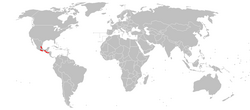 | Size: 10–12 cm (4–5 in) long, plus 10–13 cm (4–5 in) tail [60]
Habitat: Forest [61]
Diet: Seeds, nuts, berries, fruit, insects, other invertebrates, and carrion [59] | LC
Unknown  [61] [61]
|
|---|
| Big deer mouse
| P. grandis
Goodwin, 1932 | Guatemala | Size: 13–14 cm (5–6 in) long, plus 12–16 cm (5–6 in) tail [60]
Habitat: Forest [62]
Diet: Seeds, nuts, berries, fruit, insects, other invertebrates, and carrion [59] | NT
Unknown  [62] [62]
|
|---|
| Black-eared mouse  | P. melanotis
Allen & Chapman, 1897 | Southwestern United States and Mexico | Size: 9–11 cm (4–4 in) long, plus 4–8 cm (2–3 in) tail [63]
Habitat: Forest, grassland, and rocky areas [64]
Diet: Seeds, nuts, berries, fruit, insects, other invertebrates, and carrion [59] | LC
Unknown  [64] [64]
|
|---|
| Black-tailed mouse
| P. melanurus
Osgood, 1909 | Southern Mexico | Size: 11–14 cm (4–6 in) long, plus 12–15 cm (5–6 in) tail [63]
Habitat: Forest [65]
Diet: Seeds, nuts, berries, fruit, insects, other invertebrates, and carrion [59] | EN
Unknown  [65] [65]
|
|---|
| Black-wristed deer mouse 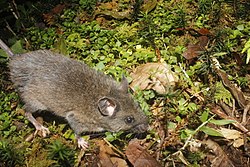 | P. melanocarpus
Osgood, 1904 | Southern Mexico | Size: 10–13 cm (4–5 in) long, plus 10–14 cm (4–6 in) tail [63]
Habitat: Forest [66]
Diet: Seeds, nuts, berries, fruit, insects, other invertebrates, and carrion [59] | EN
Unknown  [66] [66]
|
|---|
| Blackish deer mouse  | P. furvus
Allen & Chapman, 1897 | Central Mexico | Size: 11–14 cm (4–6 in) long, plus 11–17 cm (4–7 in) tail [60]
Habitat: Forest [67]
Diet: Seeds, nuts, berries, fruit, insects, other invertebrates, and carrion [59] | DD
Unknown  [67] [67]
|
|---|
| Brown deer mouse  | P. megalops
Merriam, 1898 | Southern Mexico | Size: 11–15 cm (4–6 in) long, plus 11–16 cm (4–6 in) tail [63]
Habitat: Forest [68]
Diet: Seeds, nuts, berries, fruit, insects, other invertebrates, and carrion [59] | LC
Unknown  [68] [68]
|
|---|
| Brush mouse  | P. boylii
(Baird, 1855) | Northern Mexico and western United States | Size: 8–10 cm (3–4 in) long, plus 8–12 cm (3–5 in) tail [60]
Habitat: Forest, desert, shrubland, and rocky areas [69]
Diet: Seeds, nuts, berries, fruit, insects, other invertebrates, and carrion [59] | LC
Unknown  [69] [69]
|
|---|
| Burt's deer mouse
| P. caniceps
Burt, 1932 | Montserrat island in western Mexico | Size: 8–10 cm (3–4 in) long, plus 10–13 cm (4–5 in) tail [52]
Habitat: Desert [70]
Diet: Seeds, nuts, berries, fruit, insects, other invertebrates, and carrion [59] | CR
Unknown  [70] [70]
|
|---|
| Cactus mouse  | P. eremicus
(Baird, 1858) | Northern Mexico and southwestern United States
 | Size: 7–10 cm (3–4 in) long, plus 8–12 cm (3–5 in) tail [52]
Habitat: Shrubland and desert [71]
Diet: Seeds, nuts, berries, fruit, insects, other invertebrates, and carrion [59] | LC
Unknown  [71] [71]
|
|---|
| California deermouse  | P. californicus
(Gambel, 1848) | Northwestern Mexico and southwestern United States
 | Size: 10–13 cm (4–5 in) long, plus 11–16 cm (4–6 in) tail [52]
Habitat: Shrubland and forest [72]
Diet: Seeds, nuts, berries, fruit, insects, other invertebrates, and carrion [59] | LC
Unknown  [72] [72]
|
|---|
| Canyon mouse
| P. crinitus
(Merriam, 1891) | Northwestern Mexico and western United States | Size: 7–9 cm (3–4 in) long, plus 8–12 cm (3–5 in) tail [52]
Habitat: Grassland, rocky areas, shrubland, and forest [73]
Diet: Seeds, nuts, berries, fruit, insects, other invertebrates, and carrion [59] | LC
Unknown  [73] [73]
|
|---|
| Chiapan deer mouse
| P. zarhynchus
Merriam, 1898 | Southeastern Mexico | Size: 14–15 cm (6–6 in) long, plus 15–18 cm (6–7 in) tail [60]
Habitat: Forest [74]
Diet: Seeds, nuts, berries, fruit, insects, other invertebrates, and carrion [59] | VU
Unknown  [74] [74]
|
|---|
| Chihuahuan mouse  | P. polius
Osgood, 1904 | Northern Mexico | Size: 9–12 cm (4–5 in) long, plus 12–14 cm (5–6 in) tail [10]
Habitat: Forest, shrubland, and grassland [75]
Diet: Seeds, nuts, berries, fruit, insects, other invertebrates, and carrion [59] | NT
Unknown  [75] [75]
|
|---|
| Cotton mouse 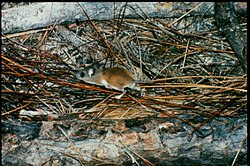 | P. gossypinus
(Le Conte, 1850) | Southeastern United States (in blue)
 | Size: 7–12 cm (3–5 in) long, plus 5–10 cm (2–4 in) tail [52]
Habitat: Intertidal marine, grassland, forest, inland wetlands, caves, and shrubland [76]
Diet: Seeds, nuts, berries, fruit, insects, other invertebrates, and carrion [59] | LC
Unknown  [76] [76]
|
|---|
| Dickey's deer mouse
| P. dickeyi
Burt, 1932 | Tortuga island in western Mexico | Size: 9–11 cm (4–4 in) long, plus 9–10 cm (4–4 in) tail [52]
Habitat: Rocky areas and shrubland [77]
Diet: Seeds, nuts, berries, fruit, insects, other invertebrates, and carrion [59] | CR
Unknown  [77] [77]
|
|---|
| Eastern deer mouse  | P. maniculatus
(Wagner, 1845) | Canada, United States, and Mexico (in gray)
 | Size: 7–10 cm (3–4 in) long, plus 4–13 cm (2–5 in) tail [63]
Habitat: Desert, rocky areas, grassland, forest, shrubland, and inland wetlands [78]
Diet: Seeds, nuts, berries, fruit, insects, other invertebrates, and carrion [59] | LC
Unknown  [78] [78]
|
|---|
| El Carrizo deer mouse  | P. ochraventer
Gloger, 1841 | Central Mexico | Size: 9–13 cm (4–5 in) long, plus 10–13 cm (4–5 in) tail [10]
Habitat: Forest [79]
Diet: Seeds, fruit, insects, and fungi [79] | EN
Unknown  [79] [79]
|
|---|
| Eva's desert mouse  | P. eva
Thomas, 1898 | Western Mexico | Size: 8–9 cm (3–4 in) long, plus 10–13 cm (4–5 in) tail [52]
Habitat: Shrubland and rocky areas [80]
Diet: Seeds, nuts, berries, fruit, insects, other invertebrates, and carrion [59] | LC
Unknown  [80] [80]
|
|---|
| False canyon mouse
| P. pseudocrinitus
Burt, 1932 | Coronados island in western Mexico | Size: 7–10 cm (3–4 in) long, plus 9–12 cm (4–5 in) tail [52]
Habitat: Coastal marine, shrubland, and rocky areas [81]
Diet: Seeds, nuts, berries, fruit, insects, other invertebrates, and carrion [59] | CR
Unknown  [81] [81]
|
|---|
| Gleaning mouse
| P. spicilegus
Allen, 1897 | Western Mexico | Size: About 10 cm (4 in) long, plus about 10 cm (4 in) tail [60]
Habitat: Forest [82]
Diet: Seeds, nuts, berries, fruit, insects, other invertebrates, and carrion [59] | LC
Unknown  [82] [82]
|
|---|
| Guatemalan deer mouse
| P. guatemalensis
Merriam, 1898 | Southern Mexico and Guatemala | Size: 13–14 cm (5–6 in) long, plus 12–16 cm (5–6 in) tail [60]
Habitat: Forest [83]
Diet: Seeds, nuts, berries, fruit, insects, other invertebrates, and carrion [59] | LC
Unknown  [83] [83]
|
|---|
| Hooper's mouse  | P. hooperi
Lee & Schmidly, 1977 | Northern Mexico | Size: 8–9 cm (3–4 in) long, plus 9–14 cm (4–6 in) tail [52]
Habitat: Grassland [84]
Diet: Seeds, nuts, insects, and other invertebrates [84] | LC
Unknown  [84] [84]
|
|---|
| La Palma deermouse
| P. sagax
(Elliot, 1903) | Central Mexico | Size: 9–11 cm (4–4 in) long, plus 9–11 cm (4–4 in) tail [60]
Habitat: Shrubland and forest [85]
Diet: Seeds, nuts, berries, fruit, insects, other invertebrates, and carrion [59] | DD
Unknown  [85] [85]
|
|---|
| Maya mouse
| P. mayensis
Carleton & Huckaby, 1975 | Guatemala | Size: 10–13 cm (4–5 in) long, plus 10–12 cm (4–5 in) tail [63]
Habitat: Forest [86]
Diet: Seeds, nuts, berries, fruit, insects, other invertebrates, and carrion [59] | CR
Unknown  [86] [86]
|
|---|
| Mesquite mouse  | P. merriami
Mearns, 1896 | Western Mexico and southwestern United States | Size: 8–10 cm (3–4 in) long, plus 9–13 cm (4–5 in) tail [52]
Habitat: Shrubland [87]
Diet: Seeds, nuts, berries, fruit, insects, other invertebrates, and carrion [59] | LC
Unknown  [87] [87]
|
|---|
| Mexican deer mouse  | P. mexicanus
(Saussure, 1860) | Southern Mexico and Central America | Size: 10–14 cm (4–6 in) long, plus 10–14 cm (4–6 in) tail [63]
Habitat: Forest, shrubland, and rocky areas [88]
Diet: Seeds, nuts, berries, fruit, insects, other invertebrates, and carrion [59] | LC
Unknown  [88] [88]
|
|---|
| Naked-eared deer mouse
| P. gymnotis
Thomas, 1894 | Southern Mexico and Central America | Size: 11–14 cm (4–6 in) long, plus 9–11 cm (4–4 in) tail [60]
Habitat: Forest [89]
Diet: Seeds, nuts, berries, fruit, insects, other invertebrates, and carrion [59] | LC
Unknown  [89] [89]
|
|---|
| Nayarit mouse  | P. simulus
Osgood, 1904 | Western Mexico | Size: About 10 cm (4 in) long, plus 9–11 cm (4–4 in) tail [60]
Habitat: Forest [90]
Diet: Seeds, nuts, berries, fruit, insects, other invertebrates, and carrion [59] | VU
Unknown  [90] [90]
|
|---|
| Nimble-footed mouse
| P. levipes
Merriam, 1898 | Central Mexico | Size: 8–11 cm (3–4 in) long, plus 9–12 cm (4–5 in) tail [60]
Habitat: Forest, shrubland, and rocky areas
Diet: Grain, fruit, and green vegetation, as well as worms, insects, molluscs, and small vertebrates | LC
Unknown 
|
|---|
| Northern Baja deer mouse  | P. fraterculus
(Miller, 1892) | Western Mexico and southwestern United States | Size: 7–10 cm (3–4 in) long, plus 9–12 cm (4–5 in) tail [52]
Habitat: Desert, shrubland, and rocky areas [92]
Diet: Seeds, nuts, berries, fruit, insects, other invertebrates, and carrion [59] | LC
Unknown  [92] [92]
|
|---|
| Northern rock mouse  | P. nasutus
(Allen, 1891) | South-central United States and northern Mexico | Size: 9–11 cm (4–4 in) long, plus 12–14 cm (5–6 in) tail [10]
Habitat: Rocky areas and forest [93]
Diet: Seeds, nuts, berries, fruit, insects, other invertebrates, and carrion [59] | LC
Unknown  [93] [93]
|
|---|
| Northwestern deer mouse
| P. keeni
(Rhoads, 1894) | Western Canada and northwestern United States
 | Size: 7–14 cm (3–6 in) long, plus 7–13 cm (3–5 in) tail [63]
Habitat: Forest, grassland, shrubland, and intertidal marine [94]
Diet: Seeds, nuts, berries, fruit, insects, other invertebrates, and carrion [59] | LC
Unknown  [94] [94]
|
|---|
| Oldfield mouse  | P. polionotus
(Wagner, 1843) | Southeastern United States (in dark green)
 | Size: 8–10 cm (3–4 in) long, plus 4–6 cm (2–2 in) tail [63]
Habitat: Shrubland, grassland, coastal marine, and intertidal marine [95]
Diet: Seeds, nuts, berries, fruit, insects, other invertebrates, and carrion [59] | LC
Unknown  [95] [95]
|
|---|
| Orizaba deer mouse
| P. beatae
(Thomas, 1903) | Southern Mexico and northern Central America | Size: 8–12 cm (3–5 in) long, plus 9–14 cm (4–6 in) tail [60]
Habitat: Forest [96]
Diet: Seeds, nuts, berries, fruit, insects, other invertebrates, and carrion [59] | LC
Unknown  [96] [96]
|
|---|
| Osgood's mouse
| P. gratus
Merriam, 1898 | Mexico and southwestern United States | Size: 9–11 cm (4–4 in) long, plus 7–13 cm (3–5 in) tail [10]
Habitat: Shrubland, forest, grassland, and rocky areas [97]
Diet: Seeds, nuts, berries, fruit, insects, other invertebrates, and carrion [59] | LC
Unknown  [97] [97]
|
|---|
| Pemberton's deer mouse †  | P. pembertoni
Burt, 1932 | San Pedro Nolasco island in western Mexico | Size: Unknown [2]
Habitat: Grassland [98]
Diet: Seeds, nuts, berries, fruit, insects, other invertebrates, and carrion [59] | EX
0  [98] [98]
|
|---|
| Schmidly's deermouse
| P. schmidlyi
Bradley, Carroll, Haynie, Martínez, Hamilton, & Kilpatrick, 2004 | Western Mexico | Size: 9–12 cm (4–5 in) long, plus 8–11 cm (3–4 in) tail [60]
Habitat: Forest [99]
Diet: Seeds, nuts, berries, fruit, insects, other invertebrates, and carrion [59] | LC
Unknown  [99] [99]
|
|---|
| Perote mouse  | P. bullatus
Osgood, 1904 | Central Mexico | Size: 8–11 cm (3–4 in) long, plus 8–12 cm (3–5 in) tail [10]
Habitat: Forest, shrubland, and grassland [100]
Diet: Seeds, nuts, berries, fruit, insects, other invertebrates, and carrion [59] | CR
Unknown  [100] [100]
|
|---|
| Pinyon mouse  | P. truei
(Shufedlt, 1885) | Western United States and southwestern Mexico | Size: 9–11 cm (4–4 in) long, plus 10–13 cm (4–5 in) tail [10]
Habitat: Desert, shrubland, forest, and rocky areas [101]
Diet: Seeds, nuts, berries, fruit, insects, other invertebrates, and carrion [59] | LC
Unknown  [101] [101]
|
|---|
| Plateau mouse
| P. melanophrys
(Coues, 1874) | Mexico (in brown)
 | Size: 7–12 cm (3–5 in) long, plus 11–18 cm (4–7 in) tail [63]
Habitat: Desert and rocky areas [102]
Diet: Seeds, nuts, berries, fruit, insects, other invertebrates, and carrion [59] | LC
Unknown  [102] [102]
|
|---|
| Puebla deer mouse
| P. mekisturus
Merriam, 1898 | Southern Mexico | Size: 8–10 cm (3–4 in) long, plus 13–16 cm (5–6 in) tail [63]
Habitat: Forest [103]
Diet: Seeds, nuts, berries, fruit, insects, other invertebrates, and carrion [59] | CR
0–50  [103] [103]
|
|---|
| San Esteban Island mouse
| P. stephani
Townsend, 1912 | San Esteban island in Western Mexico | Size: 8–10 cm (3–4 in) long, plus 10–13 cm (4–5 in) tail [60]
Habitat: Desert [104]
Diet: Seeds, nuts, berries, fruit, insects, other invertebrates, and carrion [59] | CR
Unknown  [104] [104]
|
|---|
| San Lorenzo mouse
| P. interparietalis
Burt, 1932 | Western Mexico | Size: 7–10 cm (3–4 in) long, plus 8–12 cm (3–5 in) tail [52]
Habitat: Desert [105]
Diet: Seeds, sprouts, flowers, fruit, and insects [105] | CR
Unknown  [105] [105]
|
|---|
| Santa Cruz mouse
| P. sejugis
Burt, 1932 | Western Mexico | Size: 9–11 cm (4–4 in) long, plus 6–10 cm (2–4 in) tail [63]
Habitat: Shrubland, rocky areas, and desert [106]
Diet: Seeds, nuts, berries, fruit, insects, other invertebrates, and carrion [59] | EN
Unknown  [106] [106]
|
|---|
| Slevin's mouse  | P. slevini
Mailliard, 1924 | Santa Catalina island in western Mexico | Size: 10–12 cm (4–5 in) long, plus 9–11 cm (4–4 in) tail [63]
Habitat: Shrubland and rocky areas [107]
Diet: Seeds, nuts, berries, fruit, insects, other invertebrates, and carrion [59] | CR
Unknown  [107] [107]
|
|---|
| Stirton's deer mouse
| P. stirtoni
Dickey, 1928 | Central America | Size: 9–11 cm (4–4 in) long, plus 8–11 cm (3–4 in) tail [63]
Habitat: Rocky areas and forest [108]
Diet: Seeds, nuts, berries, fruit, insects, other invertebrates, and carrion [59] | LC
Unknown  [108] [108]
|
|---|
| Tawny deer mouse
| P. perfulvus
Osgood, 1945 | Southwestern Mexico | Size: 9–13 cm (4–5 in) long, plus 12–14 cm (5–6 in) tail [63]
Habitat: Forest [109]
Diet: Seeds, nuts, berries, fruit, insects, other invertebrates, and carrion [59] | LC
Unknown  [109] [109]
|
|---|
| Texas mouse
| P. attwateri
Allen, 1895 | South-central United States | Size: 9–11 cm (4–4 in) long, plus 9–12 cm (4–5 in) tail [10]
Habitat: Forest and rocky areas [110]
Diet: Berries, acorns, seeds, plant material, and insects [110] | LC
Unknown  [110] [110]
|
|---|
| Transvolcanic deer mouse
| P. hylocetes
Merriam, 1898 | Central Mexico | Size: 10–13 cm (4–5 in) long, plus 10–12 cm (4–5 in) tail [60]
Habitat: Forest [111]
Diet: Seeds, nuts, berries, fruit, insects, other invertebrates, and carrion [59] | LC
Unknown  [111] [111]
|
|---|
| Tres Marías Island mouse  | P. madrensis
Merriam, 1898 | Mary islands in western Mexico | Size: 10–12 cm (4–5 in) long, plus 9–13 cm (4–5 in) tail [60]
Habitat: Forest [112]
Diet: Seeds, nuts, berries, fruit, insects, other invertebrates, and carrion [59] | EN
Unknown  [112] [112]
|
|---|
| White-ankled mouse  | P. pectoralis
Osgood, 1904 | Mexico and south-central United States | Size: 9–10 cm (4–4 in) long, plus 8–13 cm (3–5 in) tail [10]
Habitat: Desert, forest, grassland, rocky areas, and shrubland [113]
Diet: Seeds and insects [113] | LC
Unknown  [113] [113]
|
|---|
| White-footed mouse | P. leucopus
(Rafinesque, 1818) | Southern Canada, United States, and Mexico
 | Size: 8–11 cm (3–4 in) long, plus 4–10 cm (2–4 in) tail [63]
Habitat: Forest, desert, grassland, and shrubland
Diet: Seeds, nuts, berries, fruit, insects, other invertebrates, and carrion [59] | LC
Unknown 
|
|---|
| Winkelmann's mouse
| P. winkelmanni
Carleton, 1977 | Southwestern Mexico | Size: 11–13 cm (4–5 in) long, plus 11–14 cm (4–6 in) tail [60]
Habitat: Forest [115]
Diet: Seeds, nuts, berries, fruit, insects, other invertebrates, and carrion [59] | EN
Unknown  [115] [115]
|
|---|
| Yucatan deer mouse  | P. yucatanicus
Allen & Chapman, 1897 | Eastern Mexico and northern Guatemala | Size: 9–11 cm (4–4 in) long, plus 8–12 cm (3–5 in) tail [63]
Habitat: Forest [116]
Diet: Seeds, nuts, berries, fruit, insects, other invertebrates, and carrion [59] | LC
Unknown  [116] [116]
|
|---|
| Zacatecan deer mouse 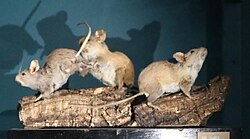 | P. difficilis
(Allen, 1891) | Mexico | Size: 10–12 cm (4–5 in) long, plus 11–14 cm (4–6 in) tail [10]
Habitat: Desert, grassland, and forest [117]
Diet: Seeds, nuts, berries, fruit, insects, other invertebrates, and carrion [59] | LC
Unknown  [117] [117]
|
|---|
































































